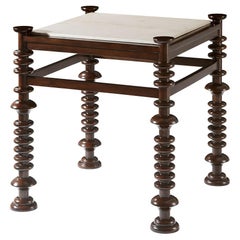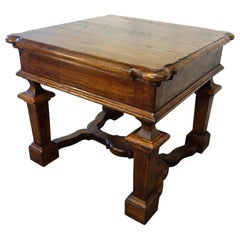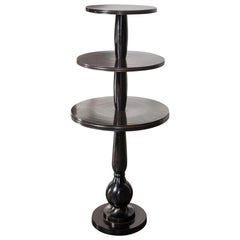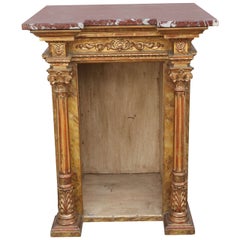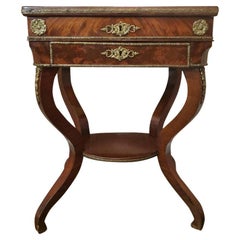21st Century and Contemporary End Tables
4
to
2
2
2
1,014
244
192
69
50
41
31
23
13
9
5
4
4
3
2
2
1
1
18
9
9
4
3
3
2
1
2
Height
to
Width
to
Depth
to
3
2
1
1
1
3
1
1
1
1
Style: Baroque
Period: 21st Century and Contemporary
Modern Turned Leg Accent Table
Located in Westwood, NJ
Modern Turned Leg Accent Table, a twist on a classic European Baroque design, turned and carved mahogany in our Cambrigde finish, with an inset...
Category
Vietnamese Baroque 21st Century and Contemporary End Tables
Materials
Stone
19th C Mediterranean Style PORTOFINO Old Walnut Table Size & Finish Options
Located in Encinitas, CA
PORTOFINO Mid Century Mediterranean Style Italian Custom Handcrafted Table Line
Introducing our re-designed Mediterranean style "Portofino" table line - the authentic Italian art & handcraft of fine, custom antique reproduction. Reminiscent of late 1950s-early 1960s Mediterranean style designs, our new "Portofino" table style shown in Old Walnut is the slim-line version of our original heavier Tuscan style Portofino table line. (See our 19th Century Tuscan style Portofino Old Walnut table...
Category
Italian Baroque 21st Century and Contemporary End Tables
Materials
Walnut
Black Metal Patina Effect Pedestal Shelves and High Table
Located in Tourcoing, FR
Antique black metal patina effect pedestal shelves and high table composed of 3 round spaces shaped as a dumbwaiter.
Category
European Baroque 21st Century and Contemporary End Tables
Materials
Aluminum
Irish Lion Mask Console Tables
Located in Sturminster Marshall, Dorset
A monumental pair of Irish Baroque carved mahogany country house serving tables with marble top and strong Romanic influence. Finished in aged Gesso and with antiqued marble tops.
W...
Category
Northern Irish Baroque 21st Century and Contemporary End Tables
Materials
Marble
Related Items
19th Century Italian Giltwood Display Table with Marble Top
Located in Los Angeles, CA
19th c. Italian Giltwood and Faux painted Display or End Table with Marble Top
Category
Italian Antique 21st Century and Contemporary End Tables
Materials
Giltwood, Paint
19th C. French Charles X Restoration Period Sewing Stand Work Table
Located in Forney, TX
A scarce period Charles X (1818-1834) French Restoration mahogany travailleuse sewing (thread stand - side table - jewelry dressing table) with light, warm, beautifully aged patina.
Born in France in the early 19th century, almost certainly Parisian work, exquisitely hand-crafted, this exceptionally executed example features ornate gilt bronze ormolu mounts, escutcheons, and elaborate gilt metal trim. Having a highly figured light mahogany hinged lid top, lifting open to reveal a striking finished interior with divided compartments and original inset mirror plate. The conforming rectangular case fitted with a faux drawer front over a dovetailed drawer with sectioned interior. Elegantly rising on oval-shaped medial shelf stretcher-joined curvacious legs.
Dimensions (approx):
27" High, 20" Wide, 13.5" Deep
Stunning light almost blonde antique mahogany coloring and mellow warm tone, superb wood grain detail, and charming, beautifully aged patina over the whole. Great shape overall. Retaining original antique character marks, wear consistent with age and indicative of minimal use, nothing that detracts from the aesthetics or functionality, but only adds to the overall authenticity, refined elegant warmth, luxurious sophistication, and cozy unpretentious rustic elegance.
Delivered cleaned, hand waxed, polished French patina finish, ready for immediate use and generational enjoyment!
What is Charles X style:
The comte d’Artois – or Charles X - was the son of the dauphin Louis-Ferdinand de Franc and Marie-Josèphe de Saxe. He succeeded his two brothers Louis XVI and Louis XVIII and became the King of France in 1824. Thirty years after the French Revolution, he wanted to embody the return of monarchy and became the leader of the catholic party . As the previous kings, he was crowned in 1825 but he was soon overthrown by the revolution in July, 1830, called "Trois Glorieuses". He left then for England, Scotland, Prague and Istria where he died in 1836.
Charles X style lasted from 1818 to 1834 and happened during the Bourbon Restoration (French Restoration). This style did not replace totally the style of furniture from the French Empire but it was different from the formalism in the Napoleonic era, during which strictness and simplicity were inspired by Greco-Roman art. Indeed, artistic fields flourished. In terms of furniture, this renewal was suggested by the softening of shapes. Even though the simple aspect from the French Empire was still visible, shapes became curvier with volutes and arabesques. Another distinction is the loss of the massive aspect of furniture and the decrease of dimensions in order to decorate smaller appartments. Handling ability and comfort were key-words in the making of furniture. Apartments had essential elements such as chests of drawers, big rounded tables in the dining room, desks or secretaries, armoires and even dressing tables, comfortable fainting couches in the living room, small tables, pedestal tables, as well as gondola chairs. The wavy aspect of the latters certainly represent Charles X style the best.
One of the most emblematic features of this style is the use of bois clairs – light woods in warm blond tones - and indigenous woods that are varnished in order to highlight the grains. Bird's-eye maple, ash trees, plane trees, yew trees, beech trees, olive trees and cedar trees were most likely to be used. Indeed, at the beginning of the 19th century dark woods were hard to find. In 1806, the Napoleon’s Continental System was established in order to ruin the United Kingdom by preventing the country from any business with the rest of Europe. Therefore craftsmen had to find alternatives from mahogany which was the most commonly used material at this time. After 1815, the import of wood was even more difficult because of peace treaties and the European political situation, which contributed to the popularity of the bois clairs and indigenous woods. The furniture was often decorated with fine inlays made out of dark wood representing foliage, which contrasted with the veneer. Even though these patterns can look like bronze decorations from the Empire era, they were far more simple and did not represent any military or mythological attributes. On the tables, trays were sometimes made out of marble as in the French Empire, but it was often put aside and inlaid veneer, Verre Eglomisé – a type of glass with a mirror finish –, mirror or porcelain from Sèvres or Paris were more likely to be used.
Decorative elements from the Monarchy were highly appreciated again as they suggested luxury. Indeed, marquetry work was particularly fashionable - Boulle marquetry thrived around 1820 as the works of the Levasseur family can show. In the same way, draperies and trimmings referred to the monarchist splendour. Fabrics were often white – the traditional colour of the Bourbons – or light coloured as oppposed to the typical green from the Napoleonic era.
One of the most symbolic figures from this period of time might be Jean-Jacques Werner (1791-1849), a cabinetmaker who worked for prestigious clients such as the Duchesse de Berry who was Charles’s step-daughter. His works can be seen at the Musée des Arts Décoratifs and at the Grand Trianon in the Palace of Versailles. The duchess’s appartments situated at the pavillon de Marsan and at the Palais de Saint Cloud illustrate Charles X style the best with furniture made out of bois clairs and ornamented with dark wood patterns or fine gold decorations.
Chales X style allows a transition between the sobriety of the Empire style and the abundant aspect of Louis-Philippe style. The gothic style started at this time through the "style à la cathédrale", inspired by religious architecture, which thrived from 1827 to 1830. Indeed, at the beginning of the 19th century, Romanticism put the spotlight on the Middle Ages. Cabinetmakers were not inspired by the medieval furniture but rather by architectural elements of churches and cathedrals. For instance the backs of chairs were decorated with arches shaped like rib and serration. In the same way, before Charles X abdicated, pieces of furniture were made out of dark woods – such as mahogany, which was used again in France – and were inlaid with light wood. Romanticism also influenced the layout of furniture in appartments to suggest movement through a mix of various styles, various shapes and various sizes, as opposed to the static aspect of Neoclassicism. The start of industrialisation and mechanisation also influenced this style as early technical developments led to the production of pieces of furniture in series.
Credit:
Marc Maison
Bibliography:
FANIEL Stéphane (Dir.), Le Dix-neuvième Siècle Français, Collection Connaissance des Arts, 1957, Hachette
SASSONE, Adriana Boidi, Furniture from Rococo to Art Deco, 2000, Evergreen
--
Extremely versatile:
As warm and attractive as it is useful, this remarkable antique table having the ideal size and small proportions for a variety of different uses, including as a side table, accent or occasional table, tall sofa...
Category
French Charles X Antique 21st Century and Contemporary End Tables
Materials
Bronze, Ormolu
19th Century Italian Renaissance Style Walnut Console Table, Tuscan End Table
Located in West Palm Beach, FL
An antique 19th century Tuscan Renaissance style table or console topped with a warm and rich colored rectangular Walnut table top, in good condition. The table base has twisted hand...
Category
Italian Renaissance Antique 21st Century and Contemporary End Tables
Materials
Metal, Wrought Iron
H 33 in W 47.5 in D 16 in
Midcentury Oval Shaped Brass Console Table Italy, 1950
Located in Rome, IT
Elegant Italian midcentury brass console table with a veneered marble top.
Finely chiseled brass decoration.
Category
Italian Mid-Century Modern Vintage 21st Century and Contemporary End Tables
Materials
Bronze
Turned Leg Table
Located in Annville, PA
Our two drawer Mahogany Turned Leg Table is based on an antique English design. Our version is slightly larger than the original to allow for modern living...
Category
Renaissance 21st Century and Contemporary End Tables
Materials
Mahogany
Dos Gallos Custom Side Tables/Nightstands with Turned Legs, Drawer and Shelv
Located in Los Angeles, CA
Custom walnut side tables or nightstands with drawer. Legs are turned and end in a low shelf.
Made in Los Angeles by Dos Gallos Studio.
PRICED PER PIECE Made to order.
As shown ...
Category
American Spanish Colonial 21st Century and Contemporary End Tables
Materials
Mahogany, Oak, Walnut
H 29.5 in W 28 in D 18 in
Narrow Walnut Wood Console Table by Alabama Sawyer
Located in Birmingham, AL
The Spider table is a narrow wood console table, rustic yet refined with traditional box joints, handcrafted with solid Alabama urban hardwood. The...
Category
American American Craftsman 21st Century and Contemporary End Tables
Materials
Walnut
Antique Ash Side Table with Turned Legs
Located in Port Chester, NY
Beautifully grained ash side, lamp, or occasional table with glossy turned legs. The top is in very good antique condition and the color and patina are very good. Slight warp to fron...
Category
French Antique 21st Century and Contemporary End Tables
Materials
Ash
19th Century Italian Renaissance Style Walnut Console Table, Antique End Table
Located in West Palm Beach, FL
An antique 19th century Tuscan Renaissance style table or console is topped with a warm and rich colored rectangular Walnut table top, in good condition. The table base has twisted h...
Category
Italian Renaissance Antique 21st Century and Contemporary End Tables
Materials
Metal, Wrought Iron
H 33 in W 47.5 in D 16 in
Narrow "Satin Walnut" Console Table Traditional Joinery by Alabama Sawyer
Located in Birmingham, AL
This Narrow "Satin Walnut" Console Table with Apron and Traditional Joinery is Rustic yet refined with seamless box joints. The Spider Console Table is hand crafted by Alabama Sawyer from Alabama urban sweet gum trees...
Category
American American Craftsman 21st Century and Contemporary End Tables
Materials
Hardwood
Late 19th Century Spanish Walnut Side Table
Located in Miami, FL
Walnut side table from the 19th century from Spain with a plank top, around the chest of drawers a hand-carved decorated molded edge and a drawer with very old iron handles, on the s...
Category
Spanish Baroque Antique 21st Century and Contemporary End Tables
Materials
Walnut
19th Century French Bouillotte Table with Breche D'alep Marble Top
Located in West Palm Beach, FL
Bouillotte occasional table, having a round top of Breche D'alep marble, surrounded by a pierced gallery of brass, on mahogany table base, with double frieze drawers, and leather-cla...
Category
French Louis XVI Antique 21st Century and Contemporary End Tables
Previously Available Items
Pair of Black Metal Side High Column Tables
Located in Tourcoing, FR
Pair of black metal side high tables.
Category
European Baroque 21st Century and Contemporary End Tables
Materials
Aluminum
Recently Viewed
View AllMore Ways To Browse
Antique Leather Lamp
End Tables Bamboo Vintage
Round End Table With Lamp
French Empire Style End Table
Lift Top End Table
Mid Century Glass Top Round End Tables
Pair Of End Tables Lucite
Ornate End Table
Gio Ponti End Tables
Mahogany Oval End Table
End Table Antique Tables End 20table Tables
Pair Teak Mid Century End Tables
Postmodern End Tables
Claw And Claw End Table
Pair Of Rattan End Tables
26 High End Table
Pair Probber Tables
Solid Rosewood End Table
